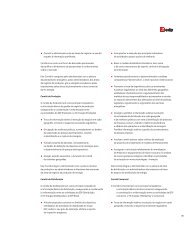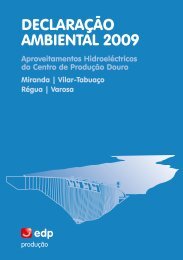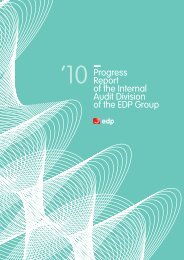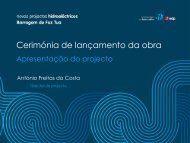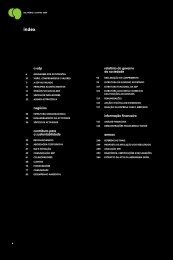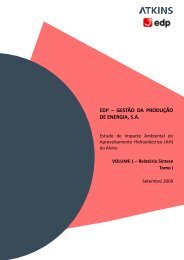: performance :3.4.1. managementsystemsIn its environmental policy <strong>EDP</strong> is committedto the constant improvement of its environmentalperformance, particularly the prevention ofpollution and minimisation of its impacts, meetingthe requirements of environmental legislationapplying to the different activities of the company,as well as other voluntary commitments it hasundertaken.A corporate environmental policy system(SIGAC) has been in place and certified, since2008, according to ISO 14001:2004, the scopeof which covers “the corporate management ofenvironmental policies and strategic environmentalplans, environmental information and theenvironmental performance of the <strong>EDP</strong> Grouporganisations”. The system establishes and fostersalignment within the group and the objective of themaintenance and extension of the environmentalcertifications for installations and activities, onthe basis of the ISO 14001:2004 standard and theEuropean Commission’s Eco-Management andAudit Scheme (EMAS).Thus, in addition to maintaining the alreadyexisting ISO 14001 and EMAS certifications, thecertification and registration plans of the variousgroup companies were complied with, overall.The effort invested in environmentally certifyingthe Group installations and activities is focusedon activities in operation, with design andconstruction and decommissioning being managedin accordance with their different specificities andcontrolled in accordance with the SIGAC.Operational objectives and targets with respectto the environmental certification systems areset annually and incorporated into the Group’sSustainability and Environment Operational Plan.These objectives and targets for all generationplants with EMAS registration can be foundat www.edp.pt> sustainability> environment>environmental management, in the respectiveenvironmental statements.3.4.2. climate change<strong>EDP</strong> maintains its strong commitment tocombating climate change on two different fronts:mitigation and adaptation. In the area of mitigationone can highlight for 2012, on the supply side, theincrease in the installed capacity in hydroelectricand wind energy power stations (~700 MW) andthe decommissioning of fuel oil power stationsin Portugal. <strong>EDP</strong> has likewise been promotingenergy efficiency improvement initiatives andstrengthening the provision of energy services onthe demand side (see page 77).As far as adaptation is concerned, <strong>EDP</strong>consolidated the Group’s climate risk managementstrategy and was also an active participant, inPortugal, in the National Adaptation to ClimateChange Strategy developed by the PortugueseEnvironmental Agency, which drew up the“<strong>Report</strong> of the Energy Sub-Group for a NationalAdaptation to Climate Change Strategy” underthe coordination of the Directorate General forEnergy and Geology.The year under review was characterised bya number of exogenous and marketcircumstances that had a significant impact onthe energy sector and a decisive influence on theenergy/environmental performance of the <strong>EDP</strong>Group’s supply. These circumstances were:º º low rainfall in Portugal and Spain (witha Hydroelectric Production Index [HPI] of lessthan 50%), which affected the generation mixand called for the more intensive operationof other thermal power stations<strong>EDP</strong> - <strong>Annual</strong> <strong>Report</strong> 2012º º the lack of an effective CO 2market, with pricesfalling heavily in 2011 and 2012 (up to €6/tonin 2012) due to a strong divergence betweensupply and demand, and affecting the order ofmerit for the entrance of power stations intothe electricity systemº º the low price of CO 2and coal in comparisonto natural gas, which has naturally beenreflected in the operation of the Iberian marketand the increase of atmospheric emissionsº º the economic and financial crisis in Europe,as well as the presence of the Troika (EC/ECB/IMF) in Portugal, leading to a contraction in theconsumption of electricity in the country (-3.6%).CO 2emission licensesIn the final year of what is known as the Kyotoperiod, a total of some 18 Mton (millions oftonnes) of CO 2emission licenses were allocatedto the <strong>EDP</strong> thermal power stations covered by theEuropean Union Emissions Trading Scheme (EU-ETS). Given the conditioning factors mentionedabove, <strong>EDP</strong> used up all its credits. Between 2013and 2020 the allocation of emission license willbe partially organised on an auction basis inaccordance with Directive 2009/29/EC, whichregulates the third phase of the EU-ETS.CO 2ALLOWANCES AWARDED TO THE GROUPIN 2012 (kt)PortugalspainPowerPlantsLicences RealAllocated Emissions PowerPlants63Licences RealAllocated EmissionsSines 5,833.3 7,785.6 Aboño 4,681.9 6,208.6Setúbal 1,119.0 17.0 Soto de Ribera 1,408.3 1,515.8Carregado 377.2 0.0Tunes 4.5 0.2 Soto 4 e 5 658.0 308.0Ribatejo 1,423.1 95.5 Castejón 627.4 322.3Lares 731.1 521.8H, CentralOviedo27.7 24.8Energin 226.0 260.7 EITOCogeneración20.3 19.8Soporgen 239.3 201.5 Tercia 52.9 66.1Fisigen 170.4 127.4 Intever 29.8 60.4Ródão 2.0 0.5 Sinova 52.9 66,1Mortágua 0.6 0.1Biogas yEnergía28.4 36.0Figueirada Foz4.8 0.5 SidergásEnergía314.1 314.1Constância 2.0 0.2 Tudela 28.4 17.3Total 10,133.2 9,010.6 Total 7,930.1 8,959.31 - Emissions from the Biomass power stations (Ródão, Mortágua, Figueira da Fozand Constância) are reported at 50%.2- Includes CO 2 emissions by the Sidergás and Aboño plants, which are fired by waste gases.(emission rights given by Arcelor, corresponding to real consumption).3- The values concerning the “CO 2 licences” differ slightly from the ones in note 48 (financialstatements) because the presented figures represent the best estimates at the date ofaccounts closing.In comparison to 2011, in which 16.9 Mton ofCO 2were emitted, there was a 6% increase inemissions in the context of the EU-ETS, whichcan essentially be put down to greater use ofcoal-fired power stations to meet consumptiondemand.For this very reason, the overall specificemissions for the <strong>EDP</strong> Group rose from 0.285tCO 2/MWh in 2011 to 0.323 tCO 2/MWh in 2012,thus distancing the company from the targetof 0.27 tCO 2/MWh set for the yearOne should notice that this target, which was setin 2005, was based on generation mix projectsthat took into consideration mean water years(HPI=1). Therefore, if 2012 had been an averageyear, hydroelectric generation in Portugal wouldhave increased by approximately 100% (-5,6 TWh)and we would have avoided the same amountof generation by thermal power stations, inparticular coal-fired power stations that featurein the base line of the load diagram. If onetakes into consideration an equal distributionof that drop in generation by the power stationsbelonging to <strong>EDP</strong> and the other companiesoperating in Portugal, one arrives at an overallCarregado thermalpower plant:decommissioning planCarregado Thermal Power Plant (710MW net installed capacity), equippedwith a conventional steam turbinetechnology, used, during its lifespan,fuel oil and natural gas. The Plantceased operation in March 2012.The undergoing DecommissioningPlan includes actions that aim atminimizing possible environmentalimpacts related with the closureof the Plant. These actions complywith applicable legislation, apply thebest practices and guarantee thefulfilment of every established safetyprocedures.Presently, there is no decisionregarding future use of both theterrain and the existing premises,which poses constraints tosubsequent works.As a consequence, the currentaction plan only addresses thedecommissioning phase, in order tolower associated risks, specificallyregarding environmental aspects.This phase is expected to beconcluded by the end of the firstquarter of 2013.Once decided future use of thePlant’s grounds and buildings,following stages, for environmentalrequalification, will be preceded byan asbestos presence and soil andunderground water contaminationassessment studies.
: performance :specific emissions figure for the <strong>EDP</strong> Groupof 0.265 tCO 2/MWh, which would be in line withthe set target. In addition to the real specificemissions figures for the 2005-2012 period,the graph above also shows, for comparisonpurposes, the estimated figures for saidemissions based on projected mean water years.SPECIFIC CO 2EMISSIONS OF <strong>EDP</strong> (gCO 2/kWh)AND REDUCTION TARGETS0.60REAL0.480.460.392005 2006 2007 20080.360.242009 2010CORRECTED WITH IPH=10.292011640.32Target 20120.27Target 20200.122012 2020Carbon Disclosure ProjectThe Carbon Disclosure Project has becomea global benchmark for the corporate reportingof direct and indirect CO 2emissions. In 2012 <strong>EDP</strong>was given a 96/100 rating for reporting and a Bin performance, which was the best reportingscore in Portugal and the fourth best in theuniverse of electricity utilities worldwide.The following table shows the direct (scope 1) andindirect (scopes 2 and 3) emissions broken downinto categories and determined in accordance withthe methodology defined in the GHG Protocol.It is noteworthy that, under the LEAN project, whichaims to promote a culture of ongoing improvement,the implementation of six initives were concluded,in order to reduce energy consumption onthe premises of the <strong>EDP</strong> Group, and helped toapproximately avoid emissions of 1,017 tCO 2.CO 2eqemissions of the edp group (kt)GrOup Portugal spain Brazil<strong>EDP</strong>Renováveisscope 1 (ktCO 2eq) 18,045.6 9,026.1 9,013.0 5,2 1.3Stationary combustion 18,004.7 9,010.6 8,994.1 - -SF6 Emissions 6.8 3.3 2.5 1.0 0.1Company fleet 18.2 11.9 1.1 4.2 1.0Natural gas consumption 0.4 0.1 0.1 - 0.2Natural gas losses(T&D)15.6 0.3 15.3 - -scope 2 (ktCO 2eq) 1,454.8 1,104.9 126.2 201.6 22.0Electricity consumptionin office buildings8.8 4.9 2.1 0.8 1.1Electricity losses(T&D)1,157.3 854.2 103.6 199.5 -Backfeed Power - Wind 288.6 245.9 20.4 1.4 21.0scope 3 (ktCO 2eq) 1,455.4 840.8 604.4 5.8 4.3Business travel 10.8 3.1 1.0 3.5 3.1Rented vehicles 0.5 0.2 0.3 0.0 0.0Employee Commuting 4.5 0.1 0.8 2.3 1.2Fuel and by-producttransportation1,405.7 803.4 602.2 0.0 0.0Outsourcers(construction site)33.9 33.9 0.0 0.0 0.0CO 2emissions avoidedThe use of renewable energy sources for thegeneration of electricity in the <strong>EDP</strong> Group hasthe environmental advantage of avoiding theuse of fossil fuels (coal, fuel oil, natural gas)to produce the same energy and consequentlyreduce greenhouse gases emissions. In recentyears, the strategy of commitment to renewablesources has resulted in a progressive increasein CO 2emissions avoided, which in 2012 reachedapproximately 22 million tonnes.Management of the carboncredits portfolio<strong>EDP</strong> has maintained the strategy it adopted inprevious years of using carbon credits acquiredboth in the primary market and the secondarymarket, in addition to the use of CO 2emissionlicenses in order to meet the emission targetsthat apply to its combustion plants in Portugal andSpain.In Brazil, where there is no carbon market inoperation, <strong>EDP</strong> has been a pioneer in the electricitysector in developing carbon credit projects.It has five Clean Development Mechanism (CDM)projects registered with the Executive Board of theUNFCCC (United Nations Framework Convention onClimate Change): increasing the power of the fourthmachine at its Mascarenhas hydroelectric powerstation; the São João and Paraíso hydroelectricpower stations; and the Água Doce and Horizontewind farms. To date, the UN has issued 40,426Certified Emission Reductions (CERs).Primary energy andefficiency of thermalpower stationsPrimary energy consumption is heavily dependent(99.8%) on combustion of fossil fuels in thermalpower stations. In 2012, it totalled 197,723 TJ,which is a slight increase (2.5%) on the precedingyear. This was, once again, a result of the intensiveuse of coal-fired power stations in Portugaland Spain. In contrast, the primary energyconsumption, in the form of fuel for the vehiclefleet, was reduced by approx. 8%.thermal efficiency in generation facilities (%)2012 2011Group Portugal spain Group Portugal spainCoal and Fuel oil 36.2 37.3 34.8 35.8 37.1 34.4CCGT 50.5 49.7 51.2 51.9 52.1 51.7CHP and waste 76.0 82.9 67.4 73.3 81.7 63.9Biomass 22.6 22.6 - 21.2 21.2 -In comparison to 2011, the yield of the coal-firedpower stations (conventional thermal powerstations) increased, as they operated in a morefavourable operating regime (load factor above80%), but decreased for the natural gas plants forprecisely the opposite reason (load factor of lessthan 10%).3.4.3. biodiversity<strong>EDP</strong> MANAGEMENT IN PROTECTED AREAS IN 2012Unit Portugal spain BrazilDistribution GridsHV Overhead km 884 101 112Underground km 14 1 0MV Overhead km 7,836 725 3,993Underground km 847 40 10Substacions no. 18 9 12Generation activity (ha) (1)Flooded areasby reservoirs (2) ha 3,074 260 0(1) The affected areas concerning wind activity are available at: www.edprenovaveis.com >Sustainability > Corporate Social Responsibility > Wind Projects(2) In Portugal, area reduction compared to 2011 is explained by a revision process. Thiswas due to an update of protected areas by national authorities and due to an update of <strong>EDP</strong>Production assets (previous values still included assets transfered to <strong>EDP</strong> Renewables). Newpower plants under construction are already included.The loss of biodiversity, and consequentdegradation of ecosystem services, is oneof today’s major concerns worldwide. Since2007, <strong>EDP</strong> has published a Biodiversity Policythat outlines a management approach aimed atachieving an overall positive balance betweenthe negative impacts of <strong>EDP</strong> operations and theminimisation, offsetting and scientific knowledgesupport measures that the company fosters andimplements. Each year a biodiversity report ispublished, highlighting a number of initiativesin course. It is available at www.edp.pt>sustainability> environment> biodiversity.A World Full Of Energy
- Page 1:
Impresso em papel elaborado com cel
- Page 6 and 7:
: edp :index6 edp6 message to share
- Page 8 and 9:
: edp :EDP - Annual Report 20127
- Page 10 and 11:
Portugalrenewablesgás7,194 Employe
- Page 12 and 13:
: edp :1.1.3. CORPORATEBODIESboard
- Page 14 and 15: : edp :1.1.5. principles ofsustaina
- Page 16 and 17: : edp :BRAzILEDP Brasil distinguish
- Page 18 and 19: : edp :1.3.2. Operating HighlightsU
- Page 20: : edp :1.3.5. ENVIRONMENT INDICATOR
- Page 24 and 25: : edp :strategicframeworkxxxxxxxxxx
- Page 26 and 27: : strategic framework :Reconversion
- Page 28 and 29: : strategic framework :EVOLUTION OF
- Page 30 and 31: : strategic framework :million at D
- Page 32 and 33: : strategic framework :Since 2005,
- Page 34: : strategic framework :EDP - Annual
- Page 38 and 39: : a edp :performance38 business40 I
- Page 40 and 41: : performance :EDP - Annual Report
- Page 42 and 43: : performance :By the end of the ye
- Page 44 and 45: : performance :electricity generati
- Page 46 and 47: : performance :EDP Distribuição h
- Page 48 and 49: : performance :electricity AND GAS
- Page 50 and 51: : performance :Despite the increase
- Page 52 and 53: : performance :electricity supply i
- Page 54 and 55: : performance :In 2012, EDPR increa
- Page 56 and 57: : performance :3.1.3. EDP BRAsILEDP
- Page 58 and 59: : performance :EDP brasilGENERATION
- Page 60 and 61: : performance :Distribution of comp
- Page 62 and 63: : performance :testing the adherenc
- Page 66 and 67: : performance :In Brazil, EDP has n
- Page 68 and 69: : performance :that 117 m 3 of oil
- Page 70 and 71: : performance :EDP has undertaken t
- Page 72 and 73: : performance :encourages professio
- Page 74 and 75: : performance :The set of indicator
- Page 76 and 77: : performance :Voice of the custome
- Page 78 and 79: : performance :(ACAPO), are also av
- Page 80 and 81: : performance :3.7. suppliersThe pe
- Page 82 and 83: : performance :Transparency; Leader
- Page 84 and 85: : performance :The following table
- Page 86: : performance :between the local au
- Page 90 and 91: : a edp :Corporate governance89 sta
- Page 92 and 93: : corporate governance :STATEMENT O
- Page 94 and 95: : corporate governance :STATEMENT O
- Page 96 and 97: : corporate governance :I. GENERALM
- Page 98 and 99: : corporate governance :In all othe
- Page 100 and 101: : corporate governance :II.1.1. Cor
- Page 102 and 103: : corporate governance :The company
- Page 104 and 105: : corporate governance :Strategy Co
- Page 106 and 107: : corporate governance :Companies C
- Page 108 and 109: : corporate governance :From 22 Feb
- Page 110 and 111: : corporate governance :The Institu
- Page 112 and 113: : corporate governance :Careers, Mo
- Page 114 and 115:
: corporate governance :Commercial
- Page 116 and 117:
: corporate governance :Corporate S
- Page 118 and 119:
: corporate governance :new matters
- Page 120 and 121:
: corporate governance :with the Eu
- Page 122 and 123:
: corporate governance :unavailabil
- Page 124 and 125:
: corporate governance :in share ca
- Page 126 and 127:
: corporate governance :II.19. Posi
- Page 128 and 129:
: corporate governance :II.26. Rule
- Page 130 and 131:
: corporate governance :II.28. Posi
- Page 132 and 133:
: corporate governance :Executive B
- Page 134 and 135:
: corporate governance :EDP has no
- Page 136 and 137:
: corporate governance :CHAPTER III
- Page 138 and 139:
: corporate governance :III.3. Hold
- Page 140 and 141:
: corporate governance :Share price
- Page 142 and 143:
: corporate governance :Capital Mar
- Page 144 and 145:
: corporate governance :III.13. Int
- Page 146 and 147:
: corporate governance :In 2012, th
- Page 151 and 152:
EDP Renováveis opensfirst wind far
- Page 153 and 154:
: financial report :5.1. edp group
- Page 155 and 156:
: financial report :these impacts,
- Page 157 and 158:
: financial report :local currency,
- Page 159 and 160:
: financial report :amount of EUR 1
- Page 161 and 162:
: financial report :EDP - Energias
- Page 163 and 164:
: financial report :EDP - Energias
- Page 165 and 166:
: financial report :EDP - Energias
- Page 167 and 168:
: financial report :EDP - Energias
- Page 169 and 170:
: financial report :EDP - Energias
- Page 171 and 172:
12.pdf 1 02/04/13 14:50notes to the
- Page 173 and 174:
notes to the consolidated EDP and -
- Page 175 and 176:
notes to the consolidated EDP and -
- Page 177 and 178:
notes to the consolidated and compa
- Page 179 and 180:
notes to the consolidated EDP and -
- Page 181 and 182:
notes to the consolidated EDP and -
- Page 183 and 184:
notes to the consolidated EDP and -
- Page 185 and 186:
notes to the consolidated EDP and -
- Page 187 and 188:
notes to the consolidated EDP and -
- Page 189 and 190:
notes to the consolidated EDP and -
- Page 191 and 192:
notes to the consolidated EDP and -
- Page 193 and 194:
notes to the consolidated EDP - and
- Page 195 and 196:
notes to the consolidated EDP and -
- Page 197 and 198:
notes to the consolidated EDP - and
- Page 199 and 200:
notes to the consolidated EDP - and
- Page 201 and 202:
notes to the consolidated EDP - and
- Page 203 and 204:
notes to the consolidated EDP and -
- Page 205 and 206:
notes to the consolidated EDP - and
- Page 207 and 208:
notes to the consolidated EDP - and
- Page 209 and 210:
notes to the consolidated and compa
- Page 211 and 212:
notes to the consolidated EDP - and
- Page 213 and 214:
notes to the consolidated EDP - and
- Page 215 and 216:
notes to the consolidated EDP - and
- Page 217 and 218:
notes to the consolidated EDP - and
- Page 219 and 220:
notes to the consolidated EDP and -
- Page 221 and 222:
notes to the consolidated EDP and -
- Page 223 and 224:
notes to the consolidated EDP - and
- Page 225 and 226:
notes to the consolidated EDP - and
- Page 227 and 228:
notes to the consolidated EDP - and
- Page 229 and 230:
notes to the consolidated EDP - and
- Page 231 and 232:
notes to the consolidated EDP and -
- Page 233 and 234:
notes to the consolidated EDP - and
- Page 235 and 236:
notes to the consolidated EDP and -
- Page 237 and 238:
notes to the consolidated EDP - and
- Page 239 and 240:
notes to the consolidated EDP - and
- Page 241 and 242:
notes to the consolidated EDP - and
- Page 243 and 244:
notes to the consolidated EDP - and
- Page 245 and 246:
EDP - Energias de Portugal, S.A.Not
- Page 247 and 248:
notes to the consolidated EDP - and
- Page 249 and 250:
notes to the consolidated EDP and -
- Page 251 and 252:
notes to the consolidatedEDPand- En
- Page 253 and 254:
notes to the consolidated EDP - and
- Page 255 and 256:
notes to the consolidated EDP and -
- Page 257 and 258:
notes to the consolidated and compa
- Page 259 and 260:
notes to the consolidated and compa
- Page 261 and 262:
notes to the consolidated and compa
- Page 263 and 264:
notes to the consolidated and compa
- Page 265 and 266:
notes to the consolidated and compa
- Page 269 and 270:
Hydroelectric powerplant of Bempost
- Page 271 and 272:
: annexes :annexesannex Ifinal refe
- Page 273 and 274:
: annexes :by Instituto Superior de
- Page 275 and 276:
: annexes :Chairman of Euronext Lis
- Page 277 and 278:
: annexes :basis. He was designated
- Page 279 and 280:
: annexes :annex IIItransactions pe
- Page 281 and 282:
: annexes :EDP’s material issues
- Page 283 and 284:
: annexes :Simultaneously, the foll
- Page 285 and 286:
: annexes :GRI complianceThis repor
- Page 287 and 288:
: annexes :286A World Full Of Energ
- Page 289 and 290:
: annexes :288A World Full Of Energ
- Page 291 and 292:
: annexes :290A World Full Of Energ
- Page 293 and 294:
: annexes :292A World Full Of Energ
- Page 295 and 296:
: annexes :294A World Full Of Energ
- Page 297 and 298:
: annexes :296A World Full Of Energ
- Page 299 and 300:
: annexes :298A World Full Of Energ
- Page 301 and 302:
: annexes :300A World Full Of Energ
- Page 303 and 304:
: annexes :302A World Full Of Energ
- Page 305 and 306:
: annexes :304A World Full Of Energ








